Whistling duck facts for kids
Quick facts for kids Whistling ducks |
|
|---|---|
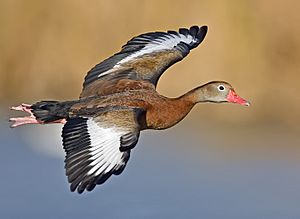 |
|
| Black-bellied whistling duck | |
| Scientific classification |
|
| Kingdom: | Animalia |
| Phylum: | Chordata |
| Class: | Aves |
| Order: | Anseriformes |
| Family: | Anatidae |
| Subfamily: | Dendrocygninae Reichenbach, 1850 |
| Genus: | Dendrocygna Swainson, 1837 |
| Type species | |
| Anas arcuata Horsfield, 1824
|
|
The whistling ducks are also known as tree ducks. They are a group of birds that belong to the same family as ducks, geese, and swans. This family is called Anatidae.
Even though they are related, whistling ducks are not considered "true ducks." Some scientists think they are a special group within the duck family, called a subfamily. Others believe they are so unique that they should be in their own separate family. There are eight types of whistling ducks alive today. They all belong to one group, or genus, called Dendrocygna.
Contents
What Are Whistling Ducks?
Whistling ducks get their name from the clear, whistling sounds they make. These birds live in warm areas around the world, especially in tropical and subtropical regions.
How to Spot a Whistling Duck
Whistling ducks have a few special features that help you recognize them. They have long legs and long necks. When they fly, they often look a bit hunched over. You can also see their black feathers under their wings during flight. Both male and female whistling ducks look very similar, with the same colored feathers. They love to be with other birds and often fly in large groups to their sleeping spots at night.
Types of Whistling Ducks
There are eight different types, or species, of whistling ducks in the Dendrocygna genus. Scientists are still learning about how these birds are related to each other. Some even think the white-backed duck from Africa and Madagascar might be a ninth type of whistling duck.
Here are the eight main species of whistling ducks:
| Common name | Scientific name | IUCN Red List Status | Where they live | Picture | ||
|---|---|---|---|---|---|---|
| Status | Trend | Population | ||||
| West Indian whistling duck | Dendrocygna arborea (Linnaeus, 1758) |
6,000 - 15,000 | 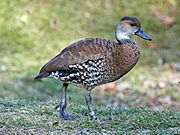 |
|||
| Wandering whistling duck | Dendrocygna arcuata (Horsfield, 1824) |
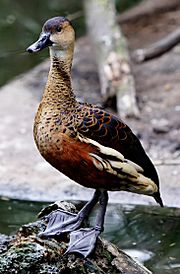 |
||||
| Black-bellied whistling duck | Dendrocygna autumnalis (Linnaeus, 1758) |
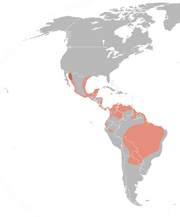 |
 |
|||
| Fulvous whistling duck | Dendrocygna bicolor (Vieillot, 1816) |
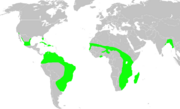 |
 |
|||
| Plumed whistling duck | Dendrocygna eytoni (Eyton, 1838) |
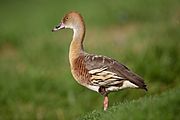 |
||||
| Spotted whistling duck | Dendrocygna guttata Schlegel, 1866 |
6,700 - 17,000 | 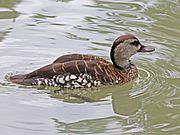 |
|||
| Lesser whistling duck | Dendrocygna javanica (Horsfield, 1821) |
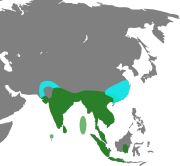 |
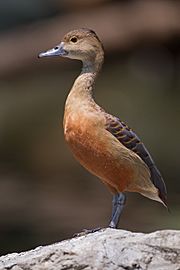 |
|||
| White-faced whistling duck | Dendrocygna viduata (Linnaeus, 1766) |
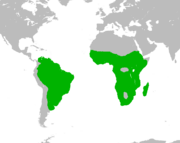 |
 |
|||
How Scientists Classify Whistling Ducks
The way scientists group and name living things is called taxonomy. It can be quite tricky! The first whistling ducks were described by Carl Linnaeus in 1758. He gave them names like Anas autumnalis and Anas arborea.
Later, in 1837, a scientist named William Swainson created the name Dendrocygna. This helped to show that whistling ducks were different from other waterfowl. The wandering whistling duck (D. arcuata) was chosen as the main example for this new group.
Scientists often disagree on the best way to classify animals. Some think whistling ducks are a special group within the duck family. Others believe they are so unique that they should be in their own separate family. Modern studies, including looking at their DNA, help scientists understand these relationships better.
Images for kids
-
Black-bellied whistling duck in flight
-
Map of Black-bellied whistling duck distribution
-
Map of Fulvous whistling duck distribution
-
Map of Lesser whistling duck distribution
-
Map of White-faced whistling duck distribution














